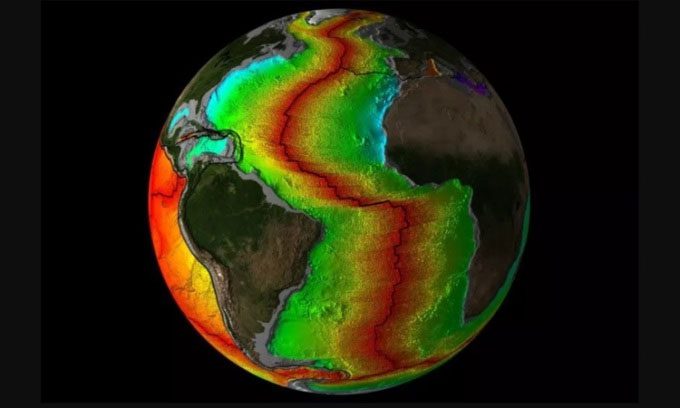Due to the Influence of Subduction Zones, the Atlantic Ocean Will Close in 20 Million Years.
Just before the continents begin to drift back together, researchers predict that a “Atlantic Ring of Fire” will form, pulling tectonic activity from the Mediterranean into the Atlantic Ocean, according to a study published in the journal Geology, reported by Newsweek on February 16. This process is expected to begin in about 20 million years. While this is a brief period in geological terms, it is extremely long for humanity.

Tectonic plates forming the Atlantic Ocean. (Photo: NOAA).
Tectonic plates are constantly moving at an incredibly slow pace. Sometimes, oceans form when tectonic plates move apart and close when they drift back together after hundreds of millions of years, in a process known as the Wilson Cycle. This very process led to the breakup of the supercontinent Pangaea around 180 million years ago, creating the Atlantic Ocean and causing the ancient Tethys Ocean to shrink into what is now the Mediterranean Sea.
For the Atlantic Ocean to close, a new subduction zone must form. This occurs where one tectonic plate is pushed down beneath another, sinking into the Earth’s mantle due to the density difference between the two plates. Typically, an oceanic plate is subducted beneath a continental or another oceanic plate.
Subduction zones are characterized by intense geological activity, including earthquakes, volcanic eruptions, and the formation of oceanic trenches. However, these areas are challenging to form because tectonic plates are very rigid, and a subduction zone requires a plate to break and bend. Nevertheless, existing subduction zones can shift during a process known as subduction invasion.
According to a study using computer modeling to predict the future tectonics from the University of Lisbon, the subduction zone in the Mediterranean beneath the Strait of Gibraltar will move deeper into the Atlantic Ocean over the next 20 million years, creating an Atlantic Ring of Fire similar to that in the Pacific. João Duarte, a researcher at the Dom Luiz Institute of the University of Lisbon, described how the Gibraltar subduction zone has slowed down over the past few million years. Few scientists believe it is still active. However, once this subduction zone enters the Atlantic, it will become more active, contributing to the closure of the Atlantic Ocean.
“There are two other subduction zones at both ends of the Atlantic: the Lesser Antilles in the Mediterranean and the Scotia Arc near Antarctica. However, these subduction zones invaded the Atlantic several million years ago. The study of the Gibraltar zone is invaluable as it allows us to observe the process at the early stage just beginning to occur,” Duarte shared.
The research team concluded that invading subduction zones could be a common way for oceans like the Atlantic to close, thus playing a crucial role in how the planet evolves geologically.


















































